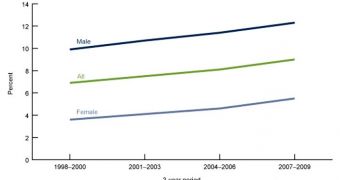The attention deficit hyperactivity disorder (ADHD) epidemic sweeping the United States displayed another spike over the past couple of years, official statistics just released by the US Centers for Disease Control and Prevention (CDC) indicate.
The rise in incidence affects both children and teenagers. Between 2007 and 2009, the report explains, more than 9 percent of children between the ages of 5 and 17 were diagnosed with the condition.
This number is up 29 percent from the 7 percent of kids that were diagnosed with ADHD between 1998 and 200. What this could imply is that the epidemic is spread ever faster, or that numerous teens and children are being given medication when they don't actually need it.
The survey from which the CDC extracted relevant data was conducted between 2007 to 2009, and included medical data on between 8,000 and 12,000 children. Scientists say that more than 40,000 households were surveyed in all, so that investigators could also assess the kids' environments.
“I would say that most probably what we found has a lot to do with better access to health care among a broader group of children, and doctors who have become more and more familiar with this condition and now have better tools to screen for it,” Dr. Lara Akinbami explains.
“So, this is probably about better screening, rather than a real increase, and that means we may continue to see this pattern unfold,” she adds. The expert is a medical officer with the CDC nation Center for Health Statistics and also the lead author of the new investigation.
In other words, what she's saying is that the condition always had such a high incidence in children, but that doctors were unable to realize the full scale of the problem until now. Interestingly, ADHD cases rose in number for both boys (from 10 to 12.3 percent) and girls (from 3.6 to 5.5 percent).
Previous difference between ethnic groups and races also subsided, with Whites, Blacks, Hispanics and Asians now displaying similar diagnosis rates. However, statistically speaking, Mexican children are the least affected by ADHD, PsychCentral reports.
“The symptoms of ADHD (inattention, impulsive behavior, and hyperactivity) begin in childhood and often persist into adulthood. These symptoms frequently lead to functional impairment in academic, family, and social settings,” the CDC press release accompanying the report explains.
“Diagnosis of ADHD involves several steps, including a medical exam; a checklist for rating ADHD symptoms based on reports from parents, teachers, and sometimes the child; and an evaluation for coexisting conditions,” the statement adds.
“Recent national surveys have documented an increase in the prevalence of ADHD during the past decade. This report presents recent trends in prevalence and differences between population subgroups of children aged 5–17 years,” it concludes.

 14 DAY TRIAL //
14 DAY TRIAL //